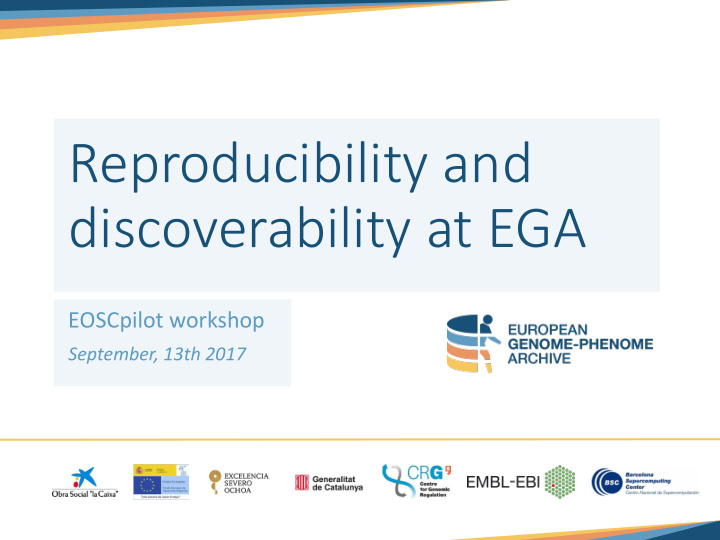



Reproducibility and discoverability at EGA EOSCpilot workshop September, 13th 2017
The EGA is a resource for permanent secure archiving and sharing of all types of potentially What is the identifiable genetic and phenotypic data resulting EGA? from biomedical research projects. Data is provided by research centers and health care institutions. Access is controlled by Data Access Committees. Data requesters are researchers from other research or health care institutions. https://ega-archive.org 2
Project goal: To transform the EGA to a joint Project goal project ( in the context of ELIXIR Europe ) to have a real impact in the development of personalized medicine The EGA was created by the EBI, in 2007, as an extension of the ENA… 3
The EGA contains a variety of data The EGA in numbers • > 1,300 Studies • 3,400 Datasets • >800 Data providers • >9,000 Data Requesters The EGA in Volume • >4 Petabytes * Updated Sept, 8th 2017 4
The EGA contains a growing amount of data 4.500 4.000 3.500 3.000 2.500 2.000 1.500 1.000 500 0 * Files encrypted in different formats are counted only once 5
The EGA is part of many international projects 6
The EGA is a key partner of ELIXIR • Ongoing projects: • EXCELERATE WP9 • 2 Human Data Implementation Studies • Beacon 2017 • Rare diseases Visualization • Finished: • EGA as a joint-venture • OncoTrack • TraIT • EGA as CORE Resource 7
Reproducibility crisis
To replicate the result of a typical computational biology paper requires 280 hours. ≈1.7 months!
What's wrong with computational workflows?: Complexity • Dozens of dependencies (binary tools, compilers, libraries, system tools, etc) • Experimental nature of academic SW tends to be difficult to install, configure and deploy • Heterogeneous executing platforms and system architecture (laptop→supercomputer)
70 tasks 55 external scripts 39 software tools & libraries * Companion parasite genome annotation pipeline, Steinbiss et al., DOI: 10.1093/nar/gkw292
Comparison of the Companion pipeline annotation of Leishmania infantum genome executed across different platforms * Platform Amazon Linux Debian Linux Mac OSX Number of chromosomes 36 36 36 Overall length (bp) 32,032,223 32,032,223 32,032,223 Number of genes 7,781 7,783 7,771 Gene density 236.64 236.64 236.32 Number of coding genes 7,580 7,580 7570 Average coding length (bp) 1,764 1,764 1,762 Number of genes with 113 113 111 multiple CDS Number of genes with 4,147 4,147 4,142 known function Number of t-RNAs 88 90 88 * Di Tommaso P, et al., Nextflow enables computational reproducibility , Nature Biotech, 2017 (publication pending)
nextflow • A framework for computational workflows • It provides a DSL to simplify the writing complex parallel workflows • Enables transparent deployment on multiple platforms • Built-in integration with containers technology
• Easy installation Easiness • Use existing tools an scripts • Implicit parallelization • Simplified deployment • Lightweight, self-contained containers Reprodu- HPC clusters cibility and cloud Git GitHub versioning
the EGA EOSCpilot project 16
The EGA EOSCpilot project: GOALS 1. Make easier to reproduce results archived at EGA 2. Avoid repeated reprocessing of the data with modern tools 3. Make artifacts involved easier to discover (FAIR) 17
Results reproducibility • EGA stores both raw and secondary analysis data • We will like to make very simple to get the published/archived from the raw data • Given the reproducibility crisis, ensuring exactitude is very desirable • Link data to the pipelines and tools used to analyze them • Pipeline and tool repositories using stable identifiers are required 18
Remastered results • Once raw data is downloaded many users will up to date them by processing against current references and using popular pipelines • This means tons of wasted resources to get the same results: human, computational and time resources • We would like to generate reproducible pipelines, run them and get the results back to the EGA • Thus users could choose to get the originals, the remastered or both • We need to actually check the popularity of such “service” • Maybe we just need to leverage work done by previous users 19
Make data more discoverable • EGA is already honoring some FAIR principles • Findable, Accessible (±), Interoperable (±), Re-usable • As we expand the number of artifacts related to the data archived at EGA, we are increasing the need to describe and link such objects • We would like to leverage the process of generating the previously described artifacts to gather metadata that would be exposed through the right tools and services. 20
Some other attributes to mention • Most of the data involved is under controlled access (not open), thus, security restrictions apply • A description of the required environment is a potential byproduct of the pilot • Using Singularity instead of Docker to avoid using root privileges at an HPC facility 21
Success criteria • Obvious: • Actually reproduce results • Get the processing artifacts permanently archived and a proposal for linking them to data • Get an updated version of the results • Have a pilot FAIR solution working • Most important: • Learn about the pros and cons of the ideas 22
credits Evan Floden, CRG Emilio Palumbo, CRG Pablo Prieto, CRG Cedric Notredame, CRG Maria Chatzou, CRG
Core organizations: THANKS! Additional sources: https://ega-archive.org/support And infrastructure support from the following sources: 24
Recommend
More recommend